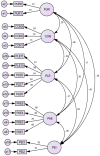Development and validation of a comprehensive tool to study the various elements influencing the utilization of E-learning among undergraduate health professions students
- PMID: 40624488
- PMCID: PMC12235846
- DOI: 10.1186/s12909-025-07582-0
Development and validation of a comprehensive tool to study the various elements influencing the utilization of E-learning among undergraduate health professions students
Abstract
Background: E-learning has emerged as a transformative approach in medical and dental education in India, offering flexibility and accessibility to students. However, there is a lack of a standardized tool to assess the multiple dimensions influencing e-learning utilization among undergraduate health profession students. This study aims to develop and validate the Comprehensive Knowledge, Attitude, and Practice Questionnaire (CKAPQ) to examine various factors affecting e-learning utilization among undergraduate medical and dental students.
Methods: The study employed a cross-sectional validation design using Zhou's Mixed Methods Model to develop and validate the CKAPQ. The initial questionnaire contained 59 items across eight theoretical factors. Content validity was assessed using the Lawshe method, and the CKAPQ survey was conducted from 2014 to 2017 among medical and dental students at a South Indian tertiary care university. Data were analyzed using exploratory factor analysis (EFA) and confirmatory factor analysis (CFA) to validate the questionnaire structure and verify the theoretical framework. Model fit was assessed using indices such as Goodness-of-Fit Index (GFI), Adjusted Goodness-of-Fit Index (AGFI), Root Mean Square Error of Approximation (RMSEA), Normed Fit Index (NFI), Comparative Fit Index (CFI), Tucker-Lewis Index (TLI), and Standardized Root Mean Square Residual (SRMR). Construct validity and structural equation modelling (SEM) were assessed.
Results: A total of 960 students (61.6% females, 38.4% males) participated in the study. Through EFA, eight items were removed based on skewness and kurtosis values, and 35 items were excluded due to factor loadings < 0.5. The Bartlett's Test of Sphericity was significant (p < 0.001), and the Kaiser-Meyer-Olkin measure (0.733) indicated sampling adequacy. The final model comprised 16 items representing five constructs with factor loadings ranging from 0.557 to 0.834. The model demonstrated good reliability (Cronbach's α ranging from 0.65 to 0.78) and strong absolute fit indices (GFI = 0.982, AGFI = 0.971, SRMR = 0.063). Construct validity was supported by Composite Reliability (0.729-0.848), Average Variance Extracted (0.516-0.669), and Maximum Shared Variance (0.143-0.304). The SEM model revealed significant correlations between constructs, with PLE and PEI showing strong positive correlation (r = 0.614), while negative correlations were observed between PLE, PEI and other factors.
Conclusion: The proposed theoretical model had eight factors, while the psychometric properties of the CKAPQ and calculations of fit revealed a five-factor model. The developed CKAPQ provides a new, standardized method to evaluate knowledge, attitudes, and practices related to E-learning among medical and dental students.
Keywords: Distance education and online learning; Media in education; Teaching/learning strategies.
© 2025. The Author(s).
Conflict of interest statement
Declarations. Competing interests: The authors declare no competing interests. Institutional review board statement: Institutional Ethics Clearance was obtained from the host institution [Sri Ramachandra Medical College and Research Institute, SRIHER (DU), Chennai, India) before recruiting the participants (ref: IEC-NI/12/OCT/30/53 dated 21.03.14). Written informed consent was obtained from students after providing a detailed description of all the components of the study. Clinical trial number: Not applicable. Informed consent: Informed consent was obtained from all subjects involved in the study. This study was conducted in full compliance with the principles outlined in the Declaration of Helsinki regarding ethical conduct of research involving human subjects. Conflict of interest: The authors declare no conflict of interest. Consent for publication: Not applicable.
Figures
Similar articles
-
A New Measure of Quantified Social Health Is Associated With Levels of Discomfort, Capability, and Mental and General Health Among Patients Seeking Musculoskeletal Specialty Care.Clin Orthop Relat Res. 2025 Apr 1;483(4):647-663. doi: 10.1097/CORR.0000000000003394. Epub 2025 Feb 5. Clin Orthop Relat Res. 2025. PMID: 39915110
-
Development and validation of a questionnaire assessing knowledge, attitude, and practice of snake envenomation among health care providers (KAPSE-HCPQ) in sub-Saharan African countries.Trop Med Int Health. 2025 Jul;30(7):662-672. doi: 10.1111/tmi.14122. Epub 2025 May 8. Trop Med Int Health. 2025. PMID: 40342260
-
Development and validation of the health belief model scale for early childhood caries prevention behaviors of parents.BMC Oral Health. 2025 Jul 2;25(1):1051. doi: 10.1186/s12903-025-06416-1. BMC Oral Health. 2025. PMID: 40604716 Free PMC article.
-
Validity and reliability study of the Turkish version of the autism spectrum knowledge scale.Acta Psychol (Amst). 2025 Aug;258:105204. doi: 10.1016/j.actpsy.2025.105204. Epub 2025 Jun 25. Acta Psychol (Amst). 2025. PMID: 40570585 Review.
-
The educational effects of portfolios on undergraduate student learning: a Best Evidence Medical Education (BEME) systematic review. BEME Guide No. 11.Med Teach. 2009 Apr;31(4):282-98. doi: 10.1080/01421590902889897. Med Teach. 2009. PMID: 19404891
References
-
- Klimova B. The Use of eLearning in Medical Education and Healthcare Practice – A Review Study [Internet]. Springer, Cham; 2018. page 933–9. Available from: https://link.springer.com/chapter/10.1007/978-3-319-64352-6_87 - DOI
-
- Hoppe HU, Joiner R, Milrad M, Sharples M. Guest editorial: wireless and mobile technologies in education. J Comput Assist Learn. 2003;19(3):255–9.
-
- El Miedany Y, e-Learning. Adaptive Learning and Mobile Learning [Internet]. Springer, Cham; 2019. page 235–58.Available from: https://link.springer.com/chapter/10.1007/978-3-319-98213-7_13
-
- Kisanjara S. (2020). Factors Influencing E-Learning Implementation in Tanzanian Universities. The Online Journal of Distance Education and e-Learning, 8, 37–54. - References - Scientific Research Publishing [Internet]. Scirp.org. 2020 [cited 2025 Jan 31]. Available from: https://www.scirp.org/reference/referencespapers?referenceid=3026964
-
- Regmi K, Jones L. A systematic review of the factors – enablers and barriers – affecting e-learning in health sciences education. BMC Medical Education [Internet]. 2020;20(1):1–18. Available from: https://bmcmededuc.biomedcentral.com/articles/10.1186/s12909-020-02007-6 - PMC - PubMed
Publication types
MeSH terms
Grants and funding
LinkOut - more resources
Full Text Sources
Miscellaneous



